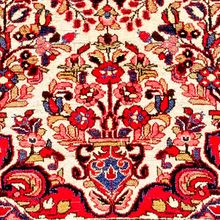Borchalu Rug
| Borchalu Rug | |
|---|---|
 Design of Borchalu Rug (Rugman) | |
| General information | |
| Name | Borchalu Rug |
| Original name | قالی برچلو |
| Alternative name(s) | Borchalu Carpet (Mosul Rug) |
| Origin | |
| Technical information | |
| Common designs | Medallion, Medallion |
| Common colors | Camel, Blue, Ivory |
| Dyeing method | Natural, Synthetic |
| Pile material | Wool |
| Foundation material | Cotton, Wool |
| Knot type | Symmetrical (Turkish) |
Borchalu rugs originate from Borchalu, a Kurdish district in northwestern Iran. Borchalu produces absolutely magnificent tribal rugs. Their predominantly long, narrow shape lends itself for use as a rug runner. Borchalu rugs are hand woven with great care by nomadic tribes living in remote areas, far away from modern civilization. Borchalu is one of the few places where single wefted rugs are tied with asymmetrical knots. Weaving is done by the women of the tribe. They educate their daughters in the age old craft of rug weaving and continue to pass down this delicate art from generation to generation. A mother and daughter may work diligently for several months to complete a single rug runner.
History
Borchalu is a village located in the southwestern Hamadan Province in western Iran. Borchalu rugs are known in the market from the 1920s. They have semigeometric designs, mostly in a medallion style.
The field, medallion, and borders feature flower heads with leaf and vine motifs in a complex design arrangement. Traditional Herati (fish) motifs are also used for the background design. Borchalu rugs are categorized as one of Hamadan's mosul. Rugs. The rugs have the unique characteristic of being larger than most Mosuls, as they are woven in sizes up to approximately seven feet by five feet, whereas most other Mosul rugs are in the "Dozar" size range, closer to six feet by four feet. A small percentage of Borchalu runners and gallery formats are woven in a variety of lengths. The rugs feature mostly reds, ivory, or dark blues for the background. In addition, varying shades of blue, brown, camel, gold, and green were used for the borders and design elements. Designs are delineated in dark blue or dark brown. Borchalu weavings have a cotton foundation and a wool pile. The Turkish (symmetric) knot is used. They are generally good to fine in grade quality. In the late twentieth century small room sizes were also made for the European market.[1]
See also
| Search for Borchalu Rug on Wikipedia. |
References
- ↑ Moheban, 2015, 117
References
- Abraham Levi Moheban. 2015. The Encyclopedia of Antique Carpets: Twenty-Five Centuries of Weaving. NewYork: Princeton Architectural Press.